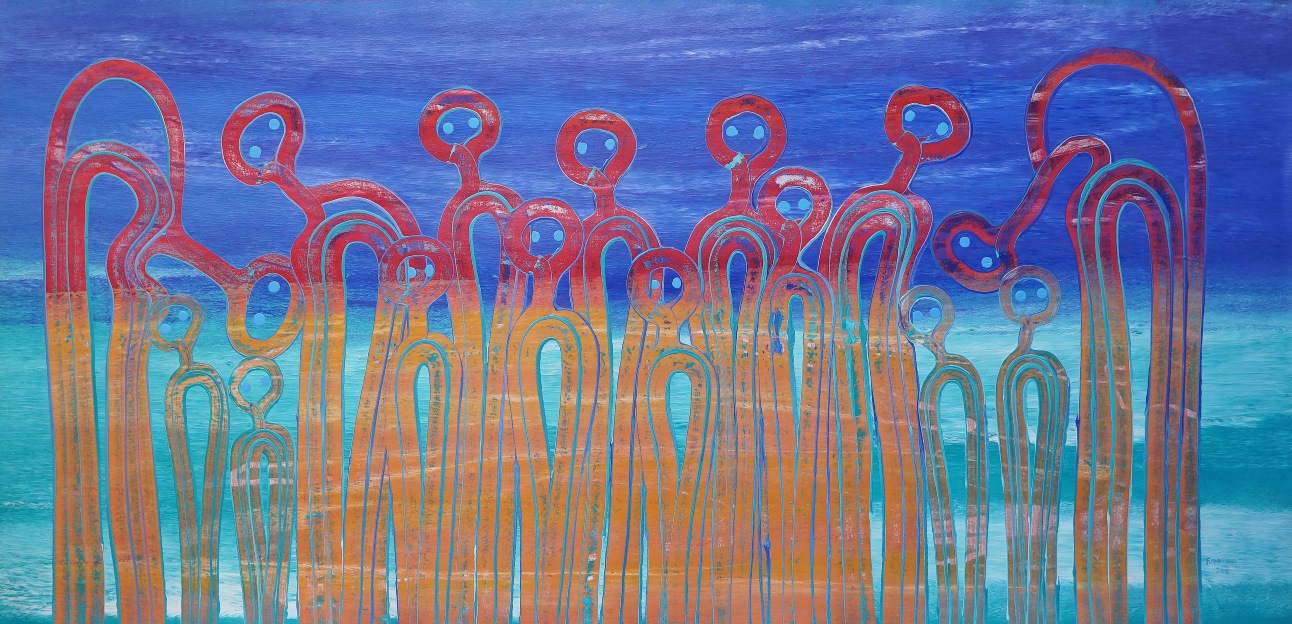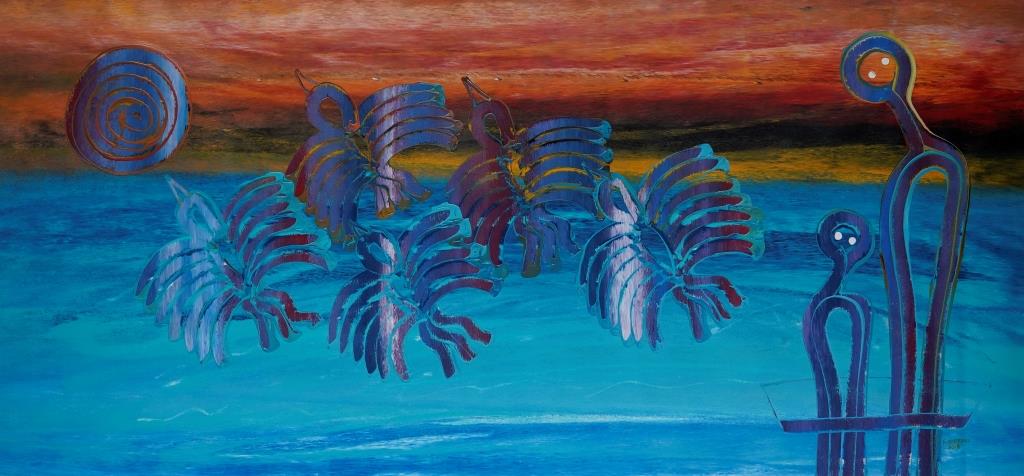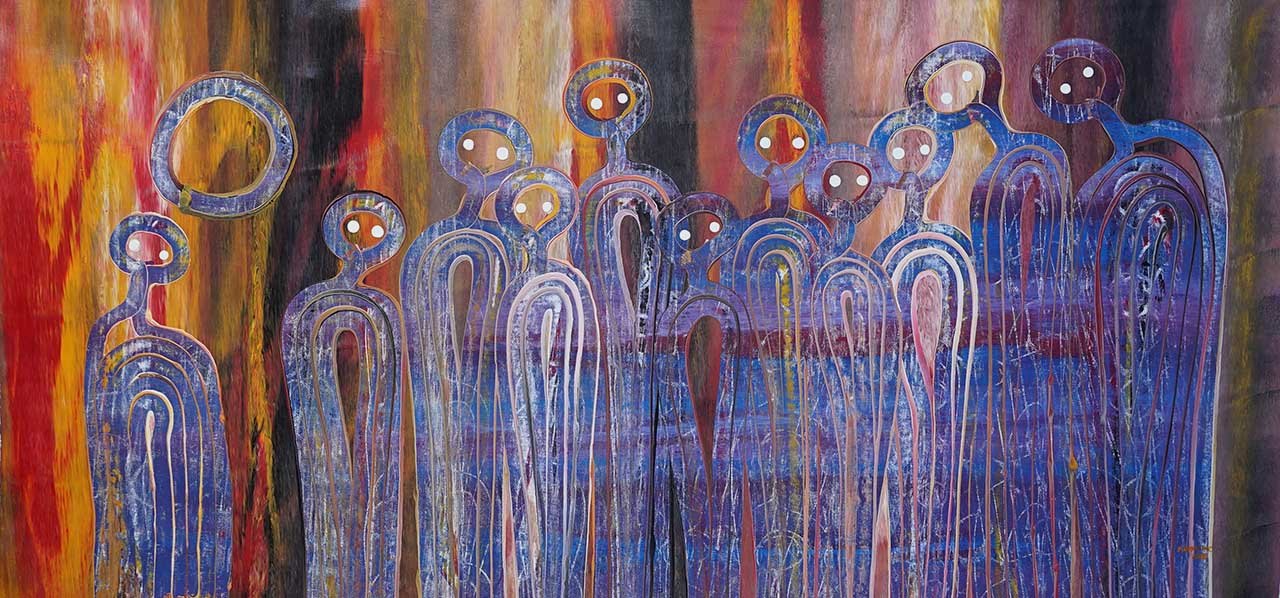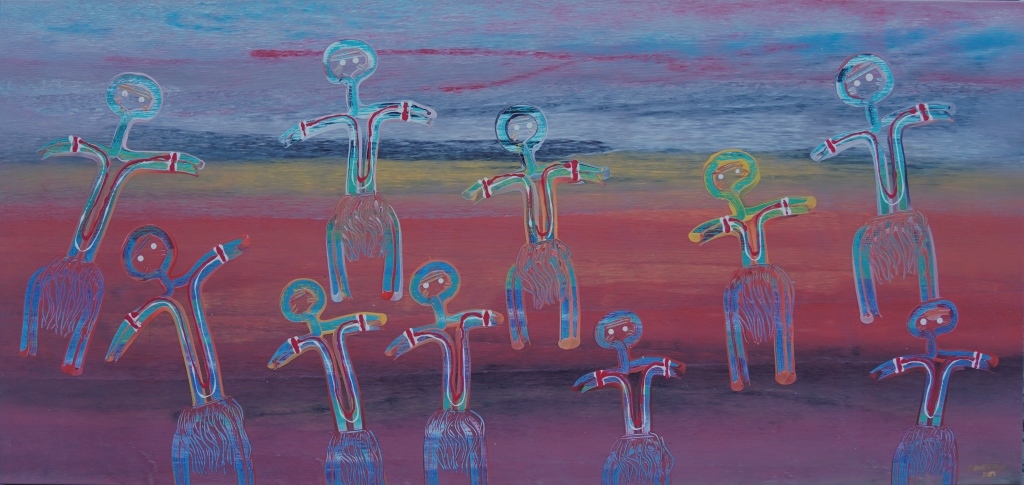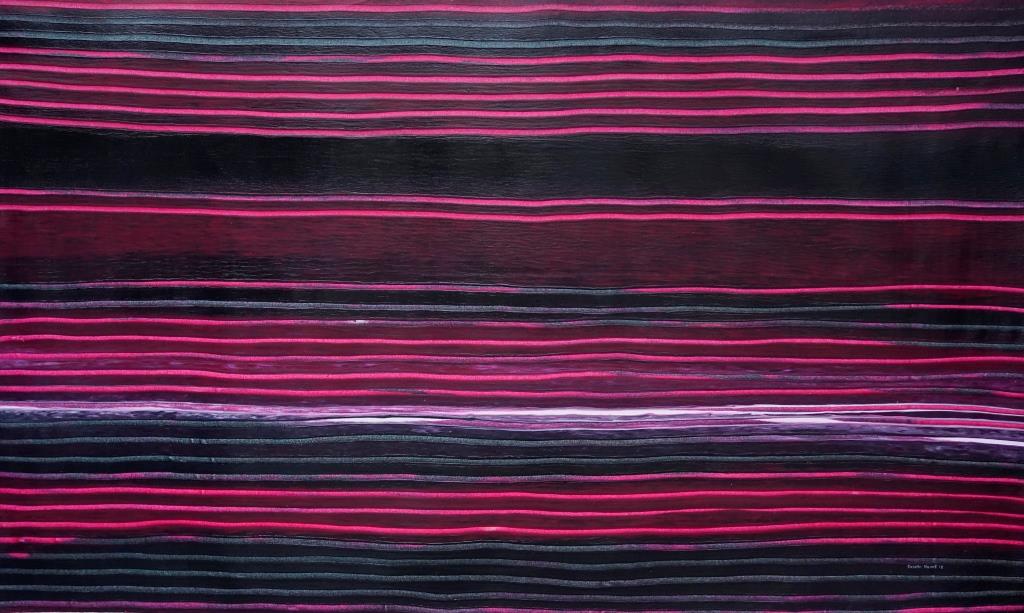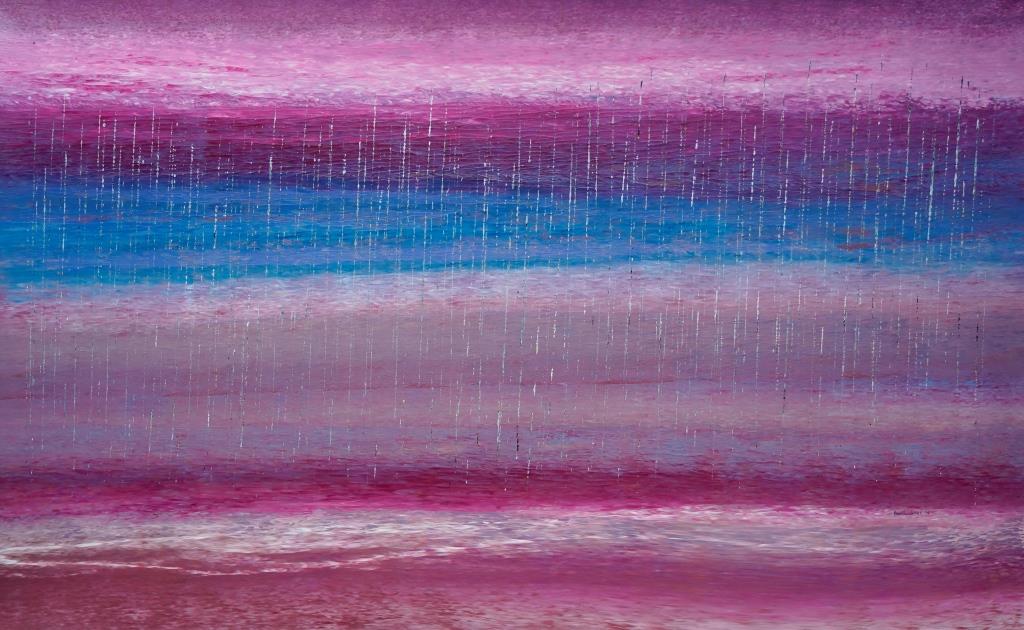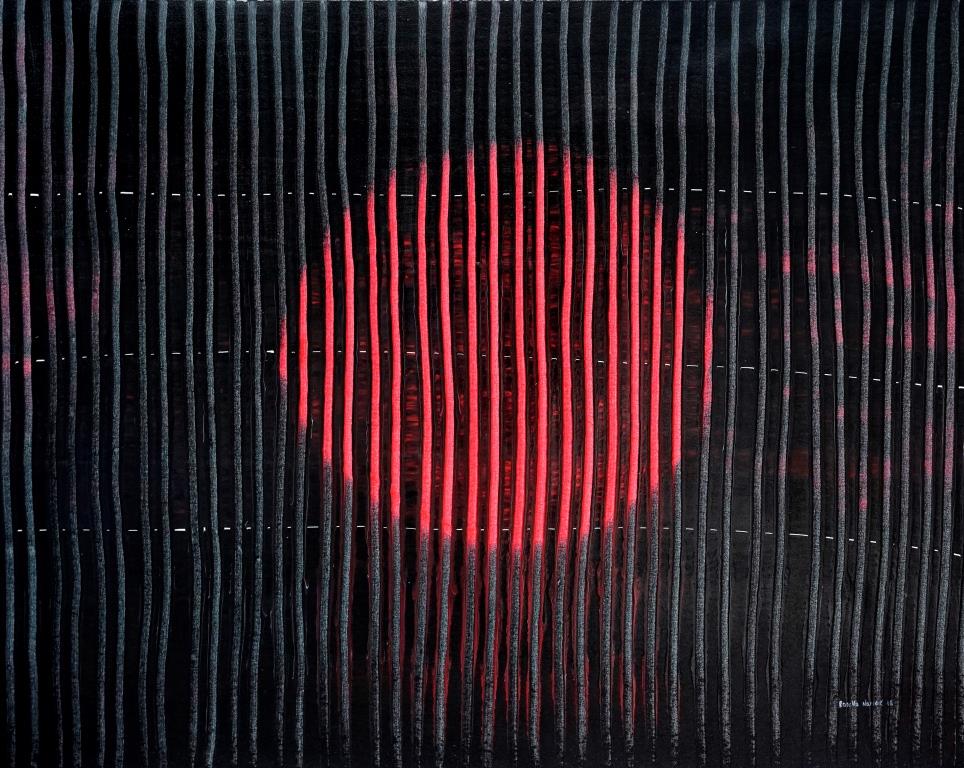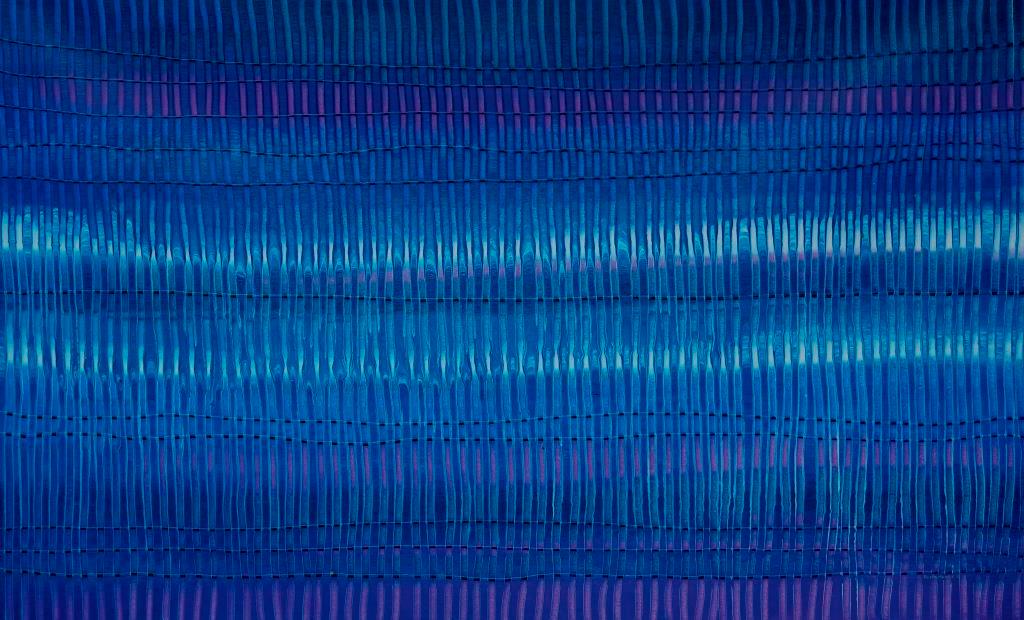Bold Colours of the Tropical Coast From Fiona Omeenyo and Rosella Namok
Exhibition Walk Through 2018: Fiona Omeenyo & Rosella Namok
Fiona Omeenyo's painting on the central wall of the gallery is entitled 'Day out on the Beach'. This is the story of her community in northern Queensland. She says that as children they grew up on the beach because that's where all her people lived. They went hunting and fishing and foraged for bush food - they knew the coastal country and all its resources. In the painting she has filled an entire canvas with the images of people and the sea - these are the familiar images that Fiona uses in her work.
To me the figures feel somewhere between the spirit of the person and the actual physical body of the people. The figures are presented in glowing colours of reds and golds and yellows against the background of the sea. This is in essence, the story of Fiona's community and her upbringing, and everything in her paintings is about her community and about elders and about growing up within the community at Lockhart River.
Nearby is this painting by Fiona showing the image of birds flying off towards the horizon. These are not any birds, they're emblematic - it's part of Fiona's totemic story of the parrot sisters. To some degree they also can represent the spirits of the people. In this large two-metre painting there are two figures in a boat, it's very stylised image of a boat and two people on the ocean, with the bird figures flying off towards the horizon. There is a sunset sky that is typical of the recent paintings by Fiona Omeenyo which have this beautiful contrast between the cool aqua blues and greens of the ocean and the bright sunset colours. The more fiery colours she puts in juxtaposition to the cool colours and this works beautifully in her paintings.
This is an intriguingl painting that the artist has entitled 'Big Family Gathering'. The entire two-metre canvas is covered with the group of figures and these are etched and drawn back into the surface of the paint. This is typical of the technique that Fiona uses in her work. The figures emerge in tones of blue and mauve and they have a patina of age as though they are wearing away back into the background. They are etched right back into the surface of the canvas, and this gives it a very edgy feeling. There's a strong sense that time or some natural force has created these images in the surface of the paint. The rich background colours are in reds, golds and orange colours, setting the figures off in stark contrast to the background. To me this is a vital and harmonious image, with the figures crowded into the canvas as though it's a big gathering of people. It is all coming together, the energy of the work and the composition, is all saying exactly that- the Big Family Gathering.
Fiona has created another large painting of ceremonial dancing figures. She’s called the work ‘Community Together – Big Dance’. In the painting there is the large group of figures all with ceremonial designs painted on their bodies and wearing grass skirts. The figures are set at different levels on the canvas as they move in this ceremonial dance. This is an on-going memory that the artist has of people performing ceremonies in the open on the beach and this remains a tradition that continues at Lockhart River today.
Alongside Fiona's paintings are a group of more structured paintings from Rosella Namok. Rosella is from the same community in northern Queensland. In contrast her paintings focus more on the landscape and the natural world, sometimes picking up on the patterns and marks found on the earth's surface that suggest different aspects of the environment. Standing in front of her painting 'Pink Bamboo Cane' you get the sense of the artist's intense observation of the natural world and its colours. There's an intense deep red/wine red colour against blue-black sections of the painting. It is very moody and very strong in colour. It is part of a group of linear, almost geometric paintings that the artist has put together in this exhibition. They suggest the very special environment of the artist's tropical home country.
The next painting on the wall is Rosella's 'Evening Rain'. Here the artist returns to the image of monsoonal summer rain and how it affects the mood of the landscape and the country. There is the sense that the ocean and the sky merge together and are reflected back at the very edge of the water meeting the sand, with rain pouring down across this image. There is a strange sense that you can look into the background and see the ocean and the horizon. You can see a sky that is rose-red with clouds above and the whole image is inverted in the wet surface of the beach. While the landscape has a feeling of depth, there is the rain with its vertical lines that bring you back to the very front of the surface of the canvas. This is a beautiful painting that maintains a tension between the depth and distance of the landscape and the veil of rain covering the whole surface of the painting.
Rosella has also painted a number of paintings from her 'Moon' series. This particular one 'Red Moon' is a contrast between the eerily reflected red colour of the moon and the surface tension created by the linear structure that is formed over the top of the black background. It gives the painting a slightly out of focus feel. I think it's the energy of the light coming off the moon. As we've just had an eclipse of the moon that has produced that blood-red image, the artist's work is an exact observation of the strange light that comes from the moon under eclipse conditions.
Rosella's painting 'Blue Lagoon' is a large canvas created within a palette of blues and mauves with contrasting bands of white. Interestingly, the colour spectrum moves in a horizontal direction across the painting and then the textural lines break up the colour with their vertical strokes. There's a connection between the colour moving across the canvas and the textural lines moving down the canvas. It creates a sense of the reflections of light on the lagoon. You have the blues merging into the purple tones and then into the lighter colours as though the light is dancing off the surface of the water. The artist achieves this effect and it makes it difficult to focus on any particular area of the painting. You just have a general sense that there is movement and a merging of colour and a ripple of texture across the entire painting suggesting the nature of the lagoon.

